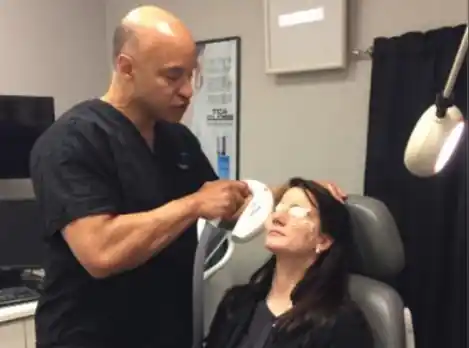Innovative Dry Eye Treatment in MS, TN & NY
Dry Eye Disease
With a legacy of over 50 years in clinical excellence, Toyos Clinic stands as a beacon of innovation in dry eye disease treatment. Toyos Clinic is committed to continuing to pursue solutions for our toughest dry eye patients including moderate to severe dry eye, neurotrophic keratitis, Sjogren’s, and other autoimmune patients.
Dr. Rolando Toyos, a pioneer in the field, invented and perfected IPL treatment for dry eye, establishing our clinic as a hub for specialized and difficult-to-treat dry eye care. Our dedicated research team also ensures that we remain at the forefront of the field, continuously advancing our understanding and providing unique treatment options for our patients.
Trust the dry eye specialists at Toyos Clinic in Nashville and Memphis for compassionate, cutting-edge solutions tailored to your needs.

Supporting Innovative Dry Eye Specialist & Eye Doctor
Pioneering Diagnosis of Dry Eyes Symptoms and Treatment Options
Dry eye disease can present discomfort and vision disturbances, impacting daily life. Insufficient tear production or poor tear quality can lead to dryness, irritation, and potential damage to the ocular surface.
- Persistent dryness or grittiness in the eyes
- Excessive tearing as a compensatory response
- Redness and inflammation
- Blurred or fluctuating vision
- Sensitivity to light
Dry eye is often a symptom of an underlying issue, such as neurotrophic keratitis, Sjogren’s syndrome, or an autoimmune issue. Discover advanced treatments at Toyos Clinic, including those invented by Dr. Rolando Toyos:
- Intense Pulsed Light (IPL): A cutting-edge treatment to address underlying causes of dry eye.
- Quantum Light Technology (The Q): Empowering patients with a portable solution for on-the-go relief.
- Dry Eye Measuring Devices: Precision tools to assess and monitor dry eye conditions for personalized care.
INTENSE PULSED LIGHT FOR DRY EYE (IPL)
With over 25 years of initial and ongoing contributions to research in dry eye, IPL treatments for dry eye were FDA approved in the spring of 2021 to treat the signs and symptoms of dry eye. IPL machines use visible and infrared light to kill Demodex, reduce inflammation, close abnormal lid margin blood vessels, and help return meibomian glands to their natural state. Dr. Rolando Toyos discovered and perfected the IPL treatment for dry eye. He also developed the Toyos Protocol used to treat dry eye by doctors and other researchers around the world - the ONLY peer-reviewed published IPL protocol. Doctors can be trained and certified at the Toyos Centers of Excellence to offer their patients this revolutionary treatment.
The Q
The Q is light technology that patients can utilize at home and on the go called, The Q, short for the Quantum. The Q complements the in office IPL treatments and can be used to extend time between IPL treatments, to treat dry eye flares and to maintain IPL results.
Safe enough to use every day on every skin type, the Q offers low energy light at a safe wavelength to stimulate the glands that produce our tears with a fraction of the energy used for in office IPL treatments. This can also be used to treat or prevent styes.

Frequently Asked Questions
What commonly causes dry eyes to occur?
Dry eyes can be caused by various factors such as aging, certain medications, hormonal changes, allergies, environmental conditions, prolonged screen time, or underlying health conditions.
Can you prescribe dry eye syndrome medication?
Yes, the specialists at Toyos Clinic can prescribe medications and treatments specifically for dry eye syndrome. However, it is important to first schedule an appointment and receive a proper diagnosis before receiving any therapy.
What are the benefits of receiving treatment from a dry eye specialist vs. over the counter?
Receiving comprehensive treatment from an innovative dry eye specialist and inventor of LPL for dry eye offers personalized care tailored to your specific needs, ensuring a more effective and targeted approach compared to over-the-counter remedies and other available treatments that may not be enough to give you relief.
How can I get started with the best dry eye specialist near me?
At Toyos Clinic, our team of highly skilled and experienced professionals is dedicated to providing the best possible care for our patients. To get started, simply schedule a consultation with one of our specialists. They will evaluate your individual needs and discuss treatment options with you.